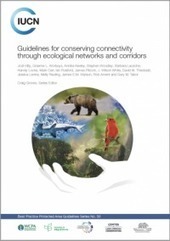Connectivity conservation is essential for managing healthy ecosystems, conserving biodiversity and adapting to climate change across all biomes and spatial scales. Well-connected ecosystems support a diversity of ecological functions such as migration, hydrology, nutrient cycling, pollination, seed dispersal, food security, climate resilience and disease resistance. These Guidelines are based on the best available science and practice for maintaining, enhancing and restoring ecological connectivity among and between protected areas, other effective areas based conservation measures (OECMs) and other intact ecosystems.
Research and publish the best content.
Get Started for FREE
Sign up with Facebook Sign up with X
I don't have a Facebook or a X account
Already have an account: Login
Revue de presse et du net par le Pôle de partage des connaissances S&T de l'Office français de la biodiversité
Curated by
DocBiodiv
 Your new post is loading... Your new post is loading...
 Your new post is loading... Your new post is loading...
|
|












Lire sur le site de l'ONG Yellowstone to Yukon Conservation Initiative (Y2Y) : Newly published guidelines make the case for connectivity in conservation https://y2y.net/blog/newly-published-guidelines-make-the-case-for-connectivity-in-conservation/